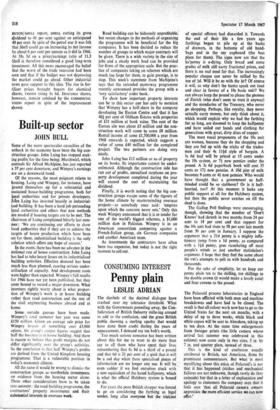Built-up sector
JOHN BULL
Some of the more spectacular casualties of the setback in the economy have been the big con- struction groups. John Laing has stopped mak- ing profits for the time being; Marchwiel, which controls Sir Alfred McAlpine, has just reported a 37 per cent downturn; and Wimpey's earnings are on a downward trend.
Of the reasons, the most poignant relates to housing. Laing and Wimpey, for instance, have geared themselves up for a substantial and sustained house-building programme, both for local authorities and for private developers. !An Laing has invested heavily in industrial- ised building. It has been a hard job persuading local authorities and others that new methods are needed if housing targets are to be met. The chairman of Laing complained bitterly last sum- mer: 'We are continuing our efforts to show local authorities that if they are to achieve the targets of house production which have been set for them, industrialised building is the only solution which offers any hope of success.'
In the event, there has been no advance in the national rate of house construction. John Laing has had to take heavy losses on its industrialised building activities. Effective demand has been much less than planned, causing serious under- utilisation of capacity. And development costs were higher than expected. Wimpey's full results for 1966 have not yet been published, but they seem bound to record a major downturn. What investors rightly worry about is what propor- tion of Wimpey's work is in house building rather than road construction and the rest of the civil engineering business abroad and at home.
Some outside guesses have been made. Wimpey's total turnover last year was some £150 million. Given an average sale price for Wimpey houses of something over £3,000 apiece, the group's output figures suggest that half the business is in house building. And there is reason to believe that profit margins do not differ significantly over the group's activities. So the conclusion is that half Wimpey's profits are derived from the United Kingdom housing programme. That is a vulnerable position in today's economic climate.
All the same it would be wrong to dismiss the construction groups as worthwhile investments on evidence from the housing sector alone. Three other considerations have to be taken into account: the road building programme, the contractors' property investments and their substantial interests in overseas work. Road building can be hideously unprofitable, but recent changes in the methods of organising the programme will be beneficial for the big companies. It has been decided to reduce the number of groups to which major contracts will be given. There is a wide variety in the size of jobs and a steady work load can be provided for firms of the appropriate scale. But the prac- tice of companies taking on schemes which are much too large for them, to gain prestige, is to stop. This week's statement from McAlpine's says that the extended motorway programme recently announced provides the group with a 'very satisfactory' order book.
To show how important property interests can be to this sector one has only to mention that Wimpey has a half-share in the company developing the Euston Centre and that it has 401 per cent of Oldham Estates with properties of £31 million at book value. The cost of the Euston site was about £5 million and the con- struction work will come to some £8 million. Rental income of some £1,700,000 a year from 1968 onwards is expected, which suggests a value of some £40 million for the completed project. The two partners are doing very nicely.
John Laing has £12 million or so of property on its books. Its importance cannot be under- estimated. Although the construction side has run out of profits, unrealised surpluses on pro- perty development completed during the year will exceed the cost of maintaining the dividend.
Finally, it is worth noting that the big con- struction groups escape some of the rigours of the home climate by masterminding overseas projects—as somebody once said: 'empires upon which the concrete never sets.' Only this week Wimpey announced that it is to tender for one of the world's biggest schemes, a $1,000 million dam in Pakistan. Wimpey is in an American consortium competing against a French-Italian group, six German companies and another American team.
As investments the contractors have often been too expensive, but today is not the right moment to sell out.






























 Previous page
Previous page